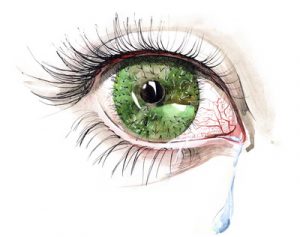
Why Are My Eyes So Dry?
Do you experience dry, scratchy, burning eyes, redness or pain, a gritty feeling like something is in your eye? Or perhaps, excessive tearing, blurred vision, eye fatigue or discomfort wearing contact lenses? There could be a number of causes for your symptoms including allergies, reactions to an irritant or medication or an infection. You could also have a chronic condition called Dry Eye Syndrome.
It’s estimated that one out of every eight adults suffers to some extent from dry eye syndrome, which can range from mild to severe. Despite the fact that it is one of the most common eye problems, a surprisingly large percentage of patients are not aware of it.
What is Dry Eye Syndrome?
Your eyes need a layer of tears to lubricate the surface and keep the eyes comfortable, clean and clear. These tears also wash away particles, dust and bacteria that can lead to infection and eye damage. Dry eye syndrome occurs when there is a chronic lack of lubrication on the surface of the eye either because not enough tears are being produced, the quality of the tears is weak or they evaporate too quickly. This causes the common uncomfortable symptoms including:
- Itching
- Burning
- Redness
- Soreness or pain
- Dryness (and sometimes even excessive tearing because the eyes are trying to compensate)
- Light sensitivity
- Eye fatigue
- Blurred vision
- Grittiness or a feeling like there is something in your eye
- Vision seems to change when blinking
Factors that Contribute to Dry Eye Syndrome
There are a number of factors that can increase your risk of suffering from Dry Eye Syndrome. While some of them are inherent, there are some environmental factors that can be changed to reduce your risk or symptoms. Risk factors include:
- Aging: While it can occur at any age, dry eye is more common in individuals over age 50.
- Women: Likely related to hormonal fluctuations, women are more likely to develop dry eyes than men, especially during pregnancy, menopause or when using birth control pills.
- Digital screen use: Whether it is a computer, a smartphone or a tablet, when our eyes are focused on a digital screen we tend to blink less, increasing tear evaporation and increasing dryness, blurriness and discomfort. Remember to regularly take a break, look away from the screen and blink several times.
- Medications: A number of medications - both prescription and nonprescription - have been found to cause dry eye symptoms including certain blood pressure regulators, antihistamines, nasal decongestants, tranquilizers and antidepressants.
- Contact lenses: Dry eyes is a common problem in contact lens wear. Several manufacturers have started offering lenses that hold more moisture to combat this common issue.
- Dry air: Whether it is the air conditioning or forced-air heating inside or the dry, windy climate outside, the environment of the air around you can contribute to dry eyes by causing your tears to evaporate too quickly.
- LASIK: One side effect of LASIK and other corneal refractive surgery is dry eyes, which usually lasts about 3-6 months and eventually resolves itself.
- Eyelid conditions: Certain conditions which prevent the eyelid from closing completely when sleeping or even blinking can cause the eye to try out.
- Allergies or infections: Chronic inflammation of the conjunctiva which is often caused by allergies or infections such as Blepharitis can result in dry eyes.
- Systemic diseases: People with autoimmune diseases or systemic conditions such as diabetes, thyroid disease, Sjogren’s syndrome, rheumatoid arthritis and lupus are also more prone to Dry Eye.
How do you treat dry eye symptoms?
If you have dry eyes, you don’t need to suffer. There are a number of treatment options that can help, depending on the severity and cause of your condition, which can reduce symptoms and enhance your comfort.
Treatments for dry eyes can include non-prescription or prescription eye drops, omega 3 supplements, special lid therapies, punctal plugs, ointments, different contact lenses, goggles or ergonomic changes to your work station. Speak to your eye doctor to discuss the cause of your dry eye and the best remedy for you. Even when it comes to the seemingly straightforward treatments like over-the-counter eye drops, they aren’t all the same. Different ingredients are tailored towards different causes of dry eye.
Get Help for Dry Eyes Today!
If you are experiencing the symptoms above, schedule an appointment with your eye doctor to find out the best solution for you.


